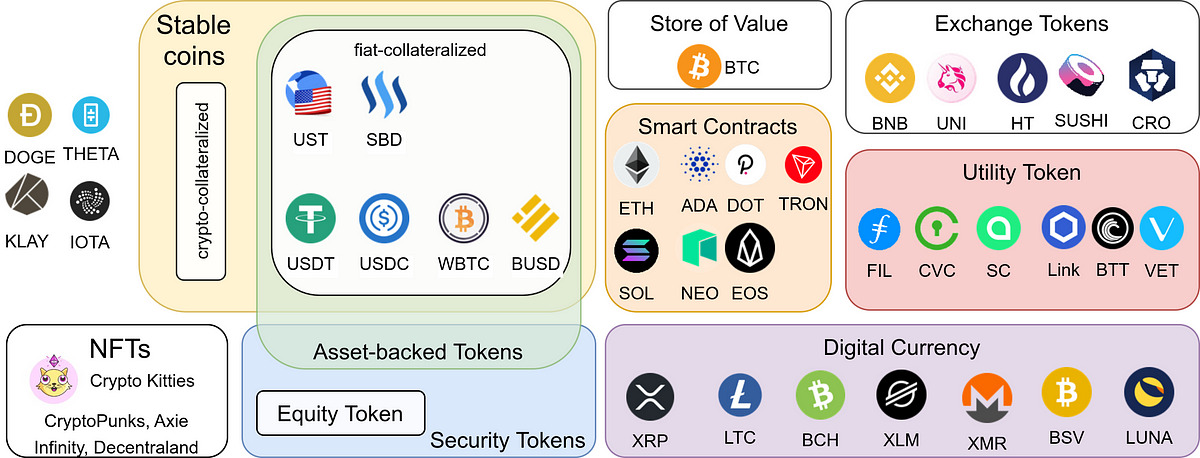Introduction
Welcome to the world of cryptocurrency, a digital form of money that has been revolutionizing the financial industry. Cryptocurrency has gained substantial attention and popularity in recent years, making it a topic of interest for many people around the world. This innovative technology has the potential to redefine traditional banking systems and reshape the way we handle financial transactions.
At its core, cryptocurrency is a type of digital or virtual currency that operates through a decentralized network called blockchain. Unlike traditional currencies such as the US Dollar or Euro, cryptocurrencies are not issued or regulated by any central authority, such as a government or financial institution. Instead, they rely on cryptography to secure transactions and control the creation of new units.
One of the key aspects that sets cryptocurrency apart from traditional forms of currency is its inherent decentralization. This means that there is no single authority or entity that controls the entire network. Instead, transactions are verified by a network of computers called nodes, which work together to maintain the integrity and security of the blockchain.
Furthermore, cryptocurrencies offer a range of unique characteristics that make them appealing to users. Firstly, they serve as a store of value, similar to traditional assets like gold or real estate. However, unlike physical assets, cryptocurrencies are purely digital and can be easily transferred between individuals or stored in digital wallets.
Additionally, cryptocurrencies can function as a medium of exchange, allowing users to conduct transactions and make purchases online. With the increasing acceptance of cryptocurrencies by merchants worldwide, their utility as a means of exchange continues to grow.
Lastly, cryptocurrencies can act as a unit of account, providing a standard measure of value for goods and services within a specific ecosystem. By designating a particular cryptocurrency as the unit of account, it becomes easier to compare prices and facilitate transactions within that network.
As we delve deeper into the world of cryptocurrency, we will explore the different types of cryptocurrencies, their volatility, security concerns, and compare them to traditional assets. Join us on this journey as we unravel the mysteries and potential of this groundbreaking form of currency.
Definition of Cryptocurrency
Cryptocurrency is a digital or virtual form of currency that utilizes cryptographic technology to secure financial transactions, control the creation of new units, and verify the transfer of assets. It is a decentralized form of currency that is not controlled or regulated by any central authority, such as a government or financial institution. Instead, cryptocurrencies rely on a network of computers called nodes, which work together to maintain the integrity and security of the blockchain.
The term “cryptocurrency” is derived from the combination of two words: “cryptography” and “currency”. Cryptography involves the use of encryption techniques to secure and protect information, ensuring that transactions and data remain confidential and tamper-proof. Currency, on the other hand, refers to a medium of exchange that is widely accepted within an economy. Cryptocurrencies combine these two concepts to create a secure and decentralized form of digital money.
One of the defining features of cryptocurrencies is their use of blockchain technology. A blockchain is a public ledger that records and verifies all transactions made with a particular cryptocurrency. It operates as a decentralized database that is continuously updated by the network of nodes. Each transaction is grouped into a block and added to the chain, ensuring transparency and immutability.
Furthermore, cryptocurrencies are typically based on complex mathematical algorithms that control the creation and supply of new units. For example, Bitcoin, the first and most well-known cryptocurrency, has a finite supply of 21 million coins. New bitcoins are created through a process called mining, where computational power is used to solve complex mathematical problems. This ensures that the creation of new units is secure, transparent, and controlled.
Unlike traditional fiat currencies, such as the US Dollar or Euro, which are backed by the trust and authority of a government, cryptocurrencies derive their value from factors such as supply and demand, utility, and market sentiment. As with any form of currency, the value of cryptocurrencies can fluctuate and vary, influenced by factors such as market trends, regulatory developments, and investor sentiment.
In summary, cryptocurrencies are digital or virtual currencies that utilize cryptographic technology and blockchain networks to provide secure transactions, control the creation and transfer of assets, and operate in a decentralized manner. They offer a range of benefits, including transparency, security, and potential for financial freedom. As we delve further into the world of cryptocurrencies, we will explore their various characteristics, types, and implications for the financial landscape.
Characteristics of Cryptocurrency
Cryptocurrencies possess several unique characteristics that set them apart from traditional forms of currency. Understanding these features is crucial for grasping the potential and implications of this digital asset class. Here are the key characteristics of cryptocurrencies:
- Decentralization: One of the fundamental traits of cryptocurrencies is their decentralized nature. Unlike traditional currencies that are governed by central banks or governments, cryptocurrencies operate on a decentralized network. This means that no single entity has control over the entire system, making it more resilient against censorship, manipulation, and political interference.
- Security: Cryptocurrencies are built upon cryptographic technology, which ensures secure and private transactions. The use of encryption techniques protects the integrity of transactions and prevents unauthorized access or fraud. The decentralized nature of cryptocurrencies also reduces the risk of hacking and data breaches associated with centralized systems.
- Transparency: Cryptocurrency transactions are recorded on a public ledger called the blockchain. This ledger is accessible to anyone and provides transparency and accountability for all transactions. This open and auditable nature of cryptocurrencies promotes trust, as users can verify and track the flow of funds in real-time.
- Immutability: Once a transaction is recorded on the blockchain, it becomes nearly impossible to alter or reverse. This immutability ensures that the historical transactions are preserved and tamper-proof. It adds an extra layer of security and trust, making cryptocurrencies resistant to fraudulent activities.
- Global Accessibility: Cryptocurrencies have a borderless nature, allowing users to transact and transfer funds seamlessly across the globe. Traditional banking systems often involve complex processes and high fees for international transactions. Cryptocurrencies eliminate these barriers, enabling quick, secure, and low-cost transfers, regardless of geographical location.
- Fractional Ownership: Unlike traditional assets, cryptocurrencies can be divided into tiny units. For example, Bitcoin can be divided up to eight decimal places, allowing for microtransactions and fractional ownership. This divisibility makes cryptocurrencies highly divisible and accessible to users with various income levels.
- Privacy: While cryptocurrencies offer transparency, they can also provide a certain level of privacy for users. Depending on the cryptocurrency, users can choose to keep their identities anonymous or pseudonymous. This privacy feature is particularly appealing for individuals who value their financial security and wish to keep their transactions discreet.
These characteristics make cryptocurrencies a disruptive and innovative form of currency. They hold the potential to transform various industries, including finance, supply chain management, and decentralized applications. As the adoption and acceptance of cryptocurrencies continue to grow, understanding these unique attributes will be essential for both individuals and businesses seeking to leverage the benefits of this digital asset class.
Store of Value
One of the key characteristics of cryptocurrencies is their ability to serve as a store of value. Similar to traditional assets like gold or real estate, cryptocurrencies have the potential to preserve and increase their value over time. Here’s how cryptocurrencies function as a store of value:
Limited Supply: Many cryptocurrencies have a finite supply, meaning that there is a maximum number of units that can ever be created. For example, Bitcoin has a supply cap of 21 million coins. This scarcity factor creates an inherent value proposition, as the limited supply prompts greater demand for the asset, potentially leading to an increase in value over time.
Inflation Hedge: Inflation, the decrease in purchasing power of a currency over time, is a concern for many individuals and investors. Traditional fiat currencies are subject to inflation as central banks can increase the money supply at will. In contrast, cryptocurrencies are often designed to be deflationary or have controlled inflation mechanisms. This design feature can offer protection against the erosion of value caused by inflation, making cryptocurrencies an attractive option for those seeking a more stable store of value.
Decentralization and Resistance to Censorship: The decentralized nature of cryptocurrencies makes them resistant to censorship and government control. Traditional assets, such as bank accounts or real estate, can be subject to governmental restrictions, freezing of funds, or confiscation. With cryptocurrencies, individuals have control over their own assets, reducing the risk of government interference and offering a secure way to store and protect wealth.
Portability and Accessibility: Cryptocurrencies are highly portable and can be easily transferred between individuals or stored in digital wallets. Unlike physical assets that may require physical custody or maintenance, cryptocurrencies can be accessed and managed conveniently through digital platforms. This accessibility makes cryptocurrencies a desirable option for individuals who want to store their value in a more flexible and easily transferable form.
Global Acceptance: Cryptocurrencies have gained increasing acceptance as a form of payment and store of value. Global marketplaces, online merchants, and even some brick-and-mortar stores are starting to accept cryptocurrencies as a valid payment option. The growing acceptance and adoption of cryptocurrencies contribute to their value as a recognized store of value.
While cryptocurrencies offer potential as a store of value, it’s important to note that their value can be subject to significant fluctuations and volatility. The market sentiment, regulatory changes, and technological advancements can all influence the value of cryptocurrencies. As with any investment, it’s essential to conduct thorough research, assess risk tolerance, and diversify investments to mitigate potential drawbacks.
In summary, cryptocurrencies offer a viable alternative as a store of value, providing benefits such as limited supply, protection against inflation, decentralization, portability, and global acceptance. As the adoption of cryptocurrencies continues to grow, their role as a store of value is likely to evolve and become more prominent in the financial landscape.
Medium of Exchange
Cryptocurrencies have emerged as a new and innovative medium of exchange, offering an alternative to traditional forms of payment. As digital currencies, they enable individuals to conduct transactions and make purchases online, providing a range of benefits and opportunities. Here are key characteristics of cryptocurrencies as a medium of exchange:
Efficiency: Cryptocurrencies facilitate fast and efficient transactions. Traditional financial systems, such as banks or third-party intermediaries, often involve cumbersome processes and delays. Cryptocurrencies streamline the payment process by eliminating intermediaries, reducing transaction costs, and enabling near-instantaneous transfers. This efficiency is particularly beneficial for cross-border transactions, where traditional methods can be costly and time-consuming.
Lower Costs: Cryptocurrencies offer lower transaction costs compared to traditional payment methods. Transactions conducted through cryptocurrencies typically involve minimal or no fees, especially for peer-to-peer transfers. This eliminates the need for intermediaries and reduces transaction costs for businesses, allowing them to potentially offer goods and services at lower prices.
Global Reach: Cryptocurrencies have a borderless nature, allowing users to conduct transactions across international boundaries without the need for currency exchange. This global reach eliminates the complexities and costs associated with traditional currency conversions, making cryptocurrencies an attractive medium of exchange for individuals and businesses operating in the global economy.
Increased Privacy: While cryptocurrencies offer transparency through their public ledger, they also provide a certain level of privacy for users. Depending on the cryptocurrency, users can choose to keep their transactions anonymous or pseudonymous. This privacy feature can be particularly appealing for individuals who value their financial security or wish to keep their transactions discreet.
Security: Cryptocurrencies utilize cryptographic technology to secure transactions and protect user information. The use of encryption techniques ensures the integrity and confidentiality of transactions, making it challenging for malicious actors to compromise the security of the payment system. This added layer of security makes cryptocurrencies a reliable medium of exchange for individuals concerned about fraud and data breaches.
Increasing Acceptance: Over the years, the acceptance of cryptocurrencies as a medium of exchange has expanded. Increasingly, merchants, online retailers, and even physical stores are adopting cryptocurrencies as a valid payment option. This growing acceptance provides individuals with more opportunities to utilize cryptocurrencies in their day-to-day transactions, further enhancing their value as a medium of exchange.
While cryptocurrencies offer numerous advantages as a medium of exchange, it’s important to acknowledge that their adoption and acceptance are still expanding. As with any emerging technology, there are challenges and limitations to overcome, such as scalability, regulatory concerns, and price volatility. However, as the technology matures and becomes more widely adopted, cryptocurrencies have the potential to reshape the way we conduct transactions and redefine the future of digital payments.
Unit of Account
Cryptocurrencies serve as a unit of account within their respective ecosystems, providing a standard measure of value for goods, services, and assets. Acting as a unit of account is one of the key roles that cryptocurrencies fulfill, allowing for easy comparison, pricing, and transactional convenience. Here’s how cryptocurrencies function as a unit of account:
Standardized Value: Cryptocurrencies provide a standardized unit of value within their networks. By designating a particular cryptocurrency as the unit of account, it becomes easier to compare prices and facilitate transactions within that specific ecosystem. Cryptocurrencies eliminate the need for multiple currency conversions, making it simpler for participants to assess the value of goods or services.
Ease of Conversion: Cryptocurrencies can be easily converted into other cryptocurrencies or traditional fiat currencies, enabling seamless transactions across different financial systems. This ease of conversion makes cryptocurrencies a flexible unit of account, allowing users to assess values and conduct transactions in various currencies depending on their preferences and needs.
Decentralized Pricing: Cryptocurrencies have a market-driven pricing mechanism that is determined by supply and demand dynamics. The decentralized nature of cryptocurrencies allows participants in the ecosystem to influence pricing through their buying and selling activities. This decentralized pricing mechanism ensures transparency and fairness in determining the value of goods, services, and assets.
Microtransactions: Cryptocurrencies can facilitate microtransactions with high divisibility. Some cryptocurrencies can be broken down into extremely small units, allowing for minute value transfers. This divisibility is essential for using cryptocurrencies as a unit of account, as it enables precise pricing and accurate measurement of value, even for very small transactions.
Smart Contract Integration: Many cryptocurrencies, such as Ethereum, have smart contract capabilities. Smart contracts are self-executing contracts with predefined rules and conditions that automatically execute transactions when those conditions are met. This integration of smart contracts into cryptocurrencies enhances the functionality of cryptocurrencies as a unit of account, enabling automated transactions based on specific criteria.
Advancing Tokenization: The development of blockchain technology has spurred the tokenization of real-world assets. By representing physical assets, such as real estate, art, or even ownership stakes in companies, with tokens on a blockchain, cryptocurrencies can act as a unit of account for these assets. This tokenization expands the use of cryptocurrencies beyond digital assets, making them a versatile unit of account.
However, it’s important to note that as cryptocurrencies continue to evolve, challenges in standardizing accounting practices and regulatory frameworks may arise. The rapid growth and innovation in the cryptocurrency space require ongoing adaptation and collaboration among industry stakeholders and regulatory authorities to ensure proper accounting and reporting standards are in place.
In summary, cryptocurrencies function as a unit of account by providing a standardized measure of value, facilitating easy conversion, employing decentralized pricing mechanisms, enabling microtransactions, integrating with smart contracts, and advancing the tokenization of real-world assets. As the adoption of cryptocurrencies expands, their role as a unit of account is likely to become more established and integrated into the wider financial landscape.
Types of Cryptocurrencies
The world of cryptocurrencies is diverse and continually evolving, with thousands of different cryptocurrencies available today. While Bitcoin is the most well-known and widely adopted cryptocurrency, there are several other types of cryptocurrencies that offer unique features and use cases. Here are some common types of cryptocurrencies:
- Bitcoin (BTC): Bitcoin is the first and most well-known cryptocurrency, introduced in 2009 by an anonymous person or group known as Satoshi Nakamoto. It operates on a decentralized network and serves as a digital store of value and medium of exchange.
- Ethereum (ETH): Ethereum is a decentralized blockchain platform developed to enable the creation of smart contracts and decentralized applications (DApps). Ether, the native cryptocurrency of the Ethereum network, is used to power these applications and provide an incentive for network participants.
- Litecoin (LTC): Litecoin, often referred to as the silver to Bitcoin’s gold, was created in 2011 by Charlie Lee. It is a peer-to-peer cryptocurrency that aims to provide faster transaction confirmation times and a different hashing algorithm compared to Bitcoin.
- Ripple (XRP): Ripple is both a digital payment protocol and a cryptocurrency. It aims to facilitate fast and low-cost international money transfers by connecting financial institutions through its network. Ripple’s native cryptocurrency, XRP, plays a role in facilitating these transactions as a bridge currency.
- Stablecoins: Stablecoins are cryptocurrencies designed to maintain a stable value by pegging their price to a specific asset or fiat currency. They aim to overcome the volatility associated with many cryptocurrencies. Tether (USDT) and USD Coin (USDC) are examples of stablecoins pegged to the value of the US Dollar.
- Privacy-focused Cryptocurrencies: Privacy-focused cryptocurrencies, such as Monero (XMR) and Zcash (ZEC), prioritize privacy and anonymity. They employ advanced cryptographic techniques to obfuscate transaction details, providing users with enhanced privacy and fungibility.
- Utility Tokens: Utility tokens are cryptocurrencies that serve a specific function within a decentralized application or on a particular platform. These tokens are often used to access or pay for services and features within the ecosystem. Examples include Binance Coin (BNB) on the Binance exchange and Basic Attention Token (BAT) within the Brave browser.
- Platform Tokens: Platform tokens represent ownership or participation in a blockchain platform’s activities. These tokens allow holders to participate in network governance, earn rewards, or receive a portion of the platform’s revenue. Examples include Tezos (XTZ), Cardano (ADA), and NEO (NEO).
The cryptocurrency market is dynamic, and new types of cryptocurrencies continue to emerge as technology advances and user needs evolve. Whether it’s focusing on privacy, offering specific functionalities, or addressing scalability challenges, the diverse range of cryptocurrencies reflects the versatility and innovation in the blockchain space.
It’s important to conduct thorough research and understand the specific characteristics, use cases, and risks associated with each type of cryptocurrency before engaging in transactions or investments.
Decentralization of Cryptocurrencies
Decentralization is a fundamental principle of cryptocurrencies and serves as a defining characteristic of these digital assets. Unlike traditional financial systems that rely on central authorities, such as banks or governments, cryptocurrencies operate on decentralized networks. Here’s a closer look at the decentralization of cryptocurrencies:
Removal of Central Authorities: Cryptocurrencies eliminate the need for intermediaries or central authorities to validate and facilitate transactions. Instead, transactions are verified by a network of computers, known as nodes, that work collaboratively to maintain the integrity and security of the blockchain network. This decentralized approach eliminates the concentration of power and control, promoting a trustless and transparent system.
Blockchain Technology: The decentralization of cryptocurrencies is made possible through the use of blockchain technology. A blockchain is a distributed ledger that records all transactions in a transparent and immutable manner. Each block of transactions is linked to the previous block, creating a chain of information. This decentralized and consensus-based approach ensures the integrity and security of the data stored within the blockchain.
Consensus Mechanisms: Cryptocurrencies employ various consensus mechanisms to validate transactions and maintain the integrity of the network. The most commonly used consensus mechanism is Proof-of-Work (PoW), where participants, known as miners, compete to solve complex mathematical puzzles to validate transactions and add blocks to the blockchain. Other consensus mechanisms, such as Proof-of-Stake (PoS) and Delegated Proof-of-Stake (DPoS), offer alternative approaches to achieving consensus while reducing energy consumption and enhancing scalability.
Resilience and Security: Due to the decentralized nature of cryptocurrencies, they are more resilient to censorship, hacking, and single points of failure. Traditional financial systems are susceptible to attacks and disruptions, as a central authority’s failure or compromise can potentially impact the entire system. In contrast, cryptocurrencies distribute the verification and storage of transaction data across a network of nodes, enhancing security and mitigating risks associated with centralized systems.
Democratic Governance: Decentralized cryptocurrencies often have governance structures that allow participants to have a say in the decision-making process. Through consensus mechanisms or voting systems, network participants can contribute to the development and improvement of the cryptocurrency’s protocols, rules, and future updates. This democratic governance model gives the community a voice and allows for greater inclusivity and transparency.
While decentralization provides significant advantages to cryptocurrencies, it also presents certain challenges. Scalability, energy consumption, and regulatory concerns are areas that require ongoing development and innovation. Additionally, the absence of intermediaries in decentralized systems means that users are responsible for the security and management of their assets, emphasizing the need for proper education and awareness.
In summary, the decentralization of cryptocurrencies removes the need for central authorities, utilizes blockchain technology, implements consensus mechanisms, enhances security and resilience, and promotes democratic governance. By operating on decentralized networks, cryptocurrencies offer a new paradigm of financial systems that are transparent, efficient, and resistant to censorship, revolutionizing the way we conduct transactions and manage assets.
Comparison with Traditional Assets
Cryptocurrencies have emerged as a new form of digital assets, posing both similarities and differences when compared to traditional assets. Understanding the distinctions between cryptocurrencies and traditional assets is essential for investors and individuals looking to diversify their portfolios. Here’s a comparison between cryptocurrencies and traditional assets:
Liquidity: Cryptocurrencies offer high liquidity, allowing users to buy, sell, and trade them quickly and easily on various cryptocurrency exchanges. In contrast, traditional assets like real estate or privately-held companies often have lower liquidity, requiring time and effort to convert them into cash.
Volatility: Cryptocurrencies are known for their price volatility, with significant price fluctuations occurring over short periods. This volatility can be an advantage for traders seeking profit opportunities but can also present risks for long-term investors. In comparison, traditional assets like stocks and bonds tend to have lower volatility, making them a more stable investment option for risk-averse individuals.
Accessibility: Cryptocurrencies have a low barrier to entry, allowing anyone with an internet connection to participate. Traditional assets, on the other hand, may have higher entry barriers due to regulatory requirements, minimum investment amounts, or limited accessibility.
Regulation: Traditional assets are subject to various regulations imposed by government entities or regulatory bodies. These regulations aim to protect investors, ensure fair practices, and maintain the stability of financial markets. Cryptocurrencies, although subject to some regulatory frameworks, generally have fewer regulations, providing greater freedom to participants but also potentially exposing them to additional risks.
Intrinsic Value: Traditional assets, such as gold, real estate, or company stocks, often possess intrinsic value based on their utility, scarcity, or earnings potential. Cryptocurrencies, on the other hand, derive their value from factors such as supply and demand dynamics, market sentiment, and adoption rates. The perceived value of cryptocurrencies can vary widely, often driven by speculative factors.
Ownership and Control: Ownership and control of traditional assets are typically established through legal contracts and property rights. With cryptocurrencies, ownership is established through private keys and digital signatures, providing individuals with direct control over their assets without relying on intermediaries. However, this also places responsibility on individuals to secure and protect their private keys to prevent unauthorized access to their cryptocurrencies.
Historical Performance: Traditional assets have a longer track record of performance, allowing investors to assess historical trends, returns, and risks associated with those assets. Cryptocurrencies, being a relatively new asset class, have less historical data available for analysis and evaluation. This can make it challenging to make informed investment decisions based solely on past performance.
While cryptocurrencies bring innovation and unique opportunities, they also carry inherent risks due to their decentralized and volatile nature. As with any investment, it’s crucial to conduct thorough research, diversify portfolios, and consider individual risk tolerance before venturing into cryptocurrencies.
In summary, cryptocurrencies differ from traditional assets in terms of liquidity, volatility, accessibility, regulation, intrinsic value, ownership, and historical performance. Understanding these differences can help individuals make informed investment decisions and effectively manage and diversify their portfolios.
Volatility and Price Fluctuations
Volatility and price fluctuations are inherent characteristics of cryptocurrencies, setting them apart from traditional assets. The cryptocurrency market is known for its high levels of volatility, with prices experiencing significant fluctuations over short periods. Understanding the factors contributing to volatility is crucial for individuals and investors considering involvement in the cryptocurrency market. Here’s a closer look at volatility and price fluctuations in the world of cryptocurrencies:
Market Sentiment: Cryptocurrencies can be heavily influenced by market sentiment, as the value of these digital assets is often driven by speculation and investor perceptions. News, announcements, regulations, and broader economic trends can trigger market sentiment shifts, causing rapid price movements. Positive news, such as the adoption of cryptocurrencies by major companies or countries, can lead to price surges, while negative news or regulatory changes can result in significant price drops.
Limited Liquidity: Cryptocurrency markets are relatively smaller and have less liquidity compared to traditional financial markets. This limited liquidity makes cryptocurrencies more susceptible to price swings, as even a relatively small amount of buying or selling pressure can have significant impacts on prices. In illiquid markets, even minor transactions can cause substantial price fluctuations.
Speculation and Trading Volume: The cryptocurrency market is highly speculative, with a significant portion of trading volume driven by short-term traders looking to profit from price volatility. These traders engage in activities like day trading, scalping, and arbitrage, amplifying price movements. Their actions can contribute to increased volatility as they seek to exploit short-term price inefficiencies.
Maturity and Regulation: The relatively young age of the cryptocurrency market and the lack of comprehensive regulation contribute to its volatility. Regulatory changes or uncertainty regarding the legal status of cryptocurrencies in specific jurisdictions can lead to price fluctuations. As the market matures and regulatory frameworks evolve, it is anticipated that the overall volatility may decrease, providing more stability for investors.
Market Manipulation: Due to the decentralized nature of cryptocurrencies, the market can be vulnerable to manipulation by large holders of specific cryptocurrencies, known as whales. These individuals or entities can influence prices by buying or selling significant amounts of a particular cryptocurrency. Their actions can create artificial price movements and exacerbate market volatility.
Emerging Technology: Cryptocurrencies are built on emerging technologies, and their value proposition often revolves around their potential applications and adoption. As a result, significant technological advancements, new partnerships, or breakthroughs in related industries can have a substantial impact on cryptocurrency prices. The relative novelty of these technologies adds an extra layer of uncertainty and volatility to the market.
It’s important to note that while volatility can result in substantial gains, it carries inherent risks, and market downturns can lead to significant losses. As with any investment, individuals should consider their risk tolerance, diversify their portfolios, and conduct thorough research before entering the cryptocurrency market.
In summary, volatility and price fluctuations are common characteristics of cryptocurrencies. Market sentiment, limited liquidity, speculation, regulatory developments, market manipulation, and emerging technology are all factors that contribute to the volatility of cryptocurrencies. Being aware of these factors can help individuals navigate the cryptocurrency market and make informed investment decisions.
Security and Risks
Cryptocurrencies offer various security features that make them attractive to users, but they are not without risks. Understanding the security measures in place and being aware of potential risks is crucial for individuals engaging with cryptocurrencies. Here’s an overview of the security and risks associated with cryptocurrencies:
Cryptography and Blockchain: Cryptocurrencies rely on cryptographic techniques to secure transactions and protect user information. The use of encryption ensures the integrity and confidentiality of transactions, making it difficult for unauthorized parties to manipulate or access users’ data. The decentralized nature of cryptocurrencies, achieved through blockchain technology, adds an additional layer of security by making it challenging for hackers to tamper with transaction records.
Wallet Security: Wallets, which are used to store cryptocurrencies, can be vulnerable to security breaches if not properly secured. Users must employ secure wallets and safeguard their private keys, which are necessary for accessing and transferring their cryptocurrencies. Failure to secure wallets can result in theft or loss of funds through hacking, phishing attacks, or physical theft of devices.
Scams and Fraudulent Projects: The cryptocurrency market has seen its fair share of scams and fraudulent projects. Ponzi schemes, fake initial coin offerings (ICOs), and pump-and-dump schemes have misled unsuspecting investors. It is essential for individuals to conduct thorough research and exercise caution when investing in new or unfamiliar cryptocurrencies or projects.
Regulatory and Legal Risks: Cryptocurrencies operate in a regulatory gray area in many jurisdictions. Changes in regulations or lack of clear regulations can impact the stability and legal status of cryptocurrencies. Individuals and businesses must stay informed about the legal and regulatory environment to ensure compliance and mitigate potential risks associated with regulatory crackdowns or restrictions.
Volatility and Market Risks: Cryptocurrencies are known for their price volatility, which can result in substantial gains but also significant losses. The market can be influenced by factors such as market sentiment, news events, and the actions of large investors. Investors must be prepared for the inherent risks of price fluctuations and take appropriate risk management measures.
Operational Risks: Although blockchain technology is generally robust, operational vulnerabilities can still exist. Bugs in smart contracts, network congestion, or coding errors can lead to hacking or financial losses. Additionally, reliance on third-party service providers, such as exchanges or wallet platforms, introduces operational risks, including potential data breaches or platform failures.
Lack of Reversibility: Transactions conducted using cryptocurrencies are generally irreversible. While this immutability ensures transaction integrity and security, it also means that mistaken or fraudulent transactions cannot be easily reversed. Users must take extra care when verifying transaction details and ensure they are sending funds to the correct addresses.
By staying vigilant, adopting best security practices, and being aware of the risks involved, individuals can minimize their exposure to potential security threats and make informed decisions when engaging with cryptocurrencies. It is advisable to seek advice from professionals and stay updated on the latest security practices to protect against emerging risks in the ever-evolving cryptocurrency landscape.
In summary, cryptocurrencies offer security through cryptographic techniques and decentralized blockchain networks. However, risks associated with wallet security, scams, regulatory changes, market volatility, operational vulnerabilities, and the irreversible nature of transactions exist. Users must remain cautious, educate themselves about security measures, and stay informed about potential risks when participating in the cryptocurrency ecosystem.
Conclusion
Cryptocurrencies have revolutionized the financial landscape, offering unique characteristics and opportunities for individuals and businesses alike. As digital assets, cryptocurrencies provide decentralized, transparent, and secure means of storing value, conducting transactions, and acting as a unit of account. Their global accessibility, efficiency, and potential for innovation make them an appealing alternative to traditional financial systems.
However, it’s important to recognize that cryptocurrencies also come with their own set of considerations and risks. Volatility and price fluctuations, while presenting opportunities for profit, require individuals to carefully assess their risk tolerance and investment strategies. Security measures, such as safeguarding private keys and conducting due diligence on projects and platforms, are crucial to protect against potential scams or hacks.
The diverse types of cryptocurrencies available, ranging from store-of-value coins to utility tokens and privacy-focused cryptocurrencies, offer various options that align with different user needs and preferences. By understanding the distinct characteristics and use cases of different cryptocurrencies, individuals can make informed decisions when investing or engaging in transactions.
The underlying technology of cryptocurrencies, blockchain, brings transparency, immutability, and increased efficiency to financial transactions. As the market continues to mature and regulations evolve, cryptocurrencies have the potential to reshape industries beyond finance, including supply chain management, digital identity, and decentralized applications.
As with any investment or emerging technology, it is important to emphasize conducting thorough research, diversifying portfolios, and seeking advice from experts to navigate the complexities and risks associated with cryptocurrencies. Ongoing education, staying informed about regulatory developments, and practicing secure storage and transaction practices will contribute to a safer and more rewarding experience in the cryptocurrency space.
In this rapidly evolving landscape, the future of cryptocurrencies remains promising. As adoption and acceptance continue to grow, cryptocurrencies have the potential to redefine how we store value, transfer funds, and interact with financial systems. Whether as a form of investment, a medium of exchange, or a tool for financial empowerment, cryptocurrencies offer individuals new avenues for participation and financial freedom.

























